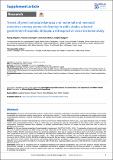| dc.contributor.author | Wagnew, Maereg | |
| dc.contributor.author | Dessalegn, Muluken | |
| dc.contributor.author | Worku, Alemayehu | |
| dc.contributor.author | Nyagero, Josephat | |
| dc.date.accessioned | 2021-08-24T19:49:08Z | |
| dc.date.available | 2021-08-24T19:49:08Z | |
| dc.date.issued | 11/26/2016 | |
| dc.identifier.citation | The Pan African Medical Journal. 2016;25 (Supp 2):12. | en_US |
| dc.identifier.issn | 1937-8688 | |
| dc.identifier.uri | http://repository.amref.org/handle/123456789/134 | |
| dc.description | © Maereg Wagnew et al. The Pan African Medical Journal - ISSN 1937-8688. This is an Open Access article distributed under the terms of the Creative Commons Attribution License (http://creativecommons.org/licenses/by/2.0), which permits unrestricted use, distribution, and reproduction in any medium, provided the original work
is properly cited. | en_US |
| dc.description.abstract | Introduction: the burden of preeclampsia has been a major concern worldwide, particularly in developing countries such as Ethiopia. Preeclampsia
is associated with substantial maternal complications, both acute and long-term. The aim of this research was to determine the magnitude and trends
of preeclampsia/ eclampsia, maternal complications, and neonatal complications among women delivering babies at selected government hospitals
in Ethiopia.
Methods: data were collected retrospectively by reviewing the five-year medical records for 2009 to 2013, using data abstraction tools, to identify
mothers with preeclampsia/eclampsia. A total of 1,809 cases were reviewed for general characteristics of the mother, delivery details, and any
complications. Descriptive analyses were employed. In addition, extended Mantel Haenszel chi square for linear trend was used to check for
significance of the trends.
Results: the five year average proportion of preeclampsia/eclampsia was 4.2% (95%CI 4.02%, 4.4%). The proportion of women with preeclampsia
was 2.2% in 2009 and increased to 5.58% in 2013 (p<0.001), which was a 154% increase. Of the 1,809 mothers with preeclampsia/eclampsia, 36%
(95%CI 33.85%, 38.28%) experienced at least one maternal complication; there was an increase of 26.5% (p<0.01) over the five year period. The
main complications were HELLP (variant of preeclampsia with hemolysis, elevated liver enzymes, and low platelet count) syndrome, 257 (39.5%);
aspiration pneumonia, 114 (17.5%); pulmonary edema, 114 (17.5%); and abruption placentae, 100 (15.3%). At least one neonatal complication
occurred in 66.4% (95%CI 64.24%, 68.59%) of deliveries during the five-year study. A decreasing trend in neonatal complications was observed
from 2009 (76%) to 2013 (66%), which showed a percentage change over time of negative 13.2%. The most common neonatal complications were
stillbirths, which accounted for 363 (30.2%); prematurity, with 395 (32.8%); respiratory distress syndrome, with 456 (37.9%); and low birth weight,
with 363 (30.2%).
Conclusion: there was an increasing trend of preeclampsia/eclampsia and maternal complications over a five year period in selected maternity
governmental hospitals. In contrast, neonatal complications experienced a significant decrease over the five-year period. It is essential to raise
awareness among mothers in the community regarding early signs and symptoms of preeclampsia/eclampsia and to design a better tracking system
for antenatal care programs. | en_US |
| dc.description.sponsorship | African Medical Research Foundation | en_US |
| dc.language.iso | en | en_US |
| dc.publisher | Pan African Medical Journal | en_US |
| dc.relation.ispartofseries | Strengthening health systems in communities: the experiences of AMREF Health Africa;Supp. 2: 12 | |
| dc.subject | Preeclampsia-eclampsia | en_US |
| dc.subject | Maternal-neonatal complications | en_US |
| dc.subject | HELLP | en_US |
| dc.subject | Still birth | en_US |
| dc.subject | Hospital | en_US |
| dc.title | Trends of preeclampsia/eclampsia and maternal and neonatal outcomes among women delivering in Addis Ababa selected government hospitals, Ethiopia: a retrospective cross-sectional study | en_US |
| dc.type | Article, Journal | en_US |

